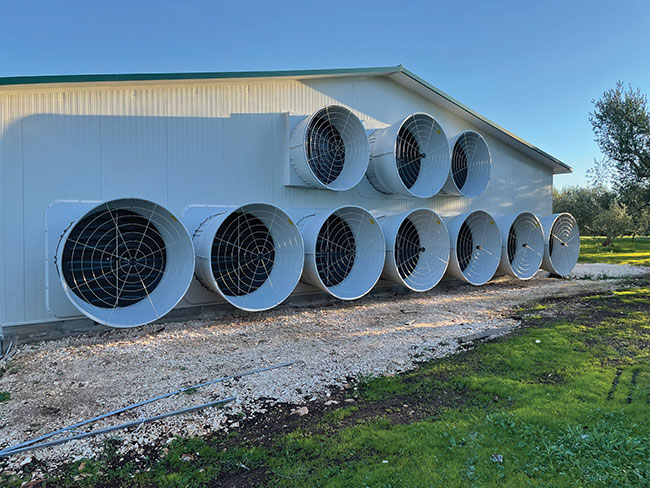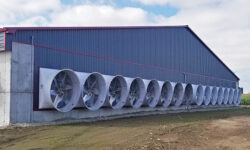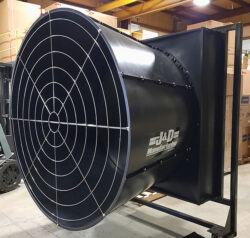
Air quality tech roundup
By Treena Hein
Features New TechnologyLarger fans, more efficient fans and more automation to fine-tune operation – those are the top trends in poultry barn fan technology for 2023.
 Skov offers the BF 55 BlueFan, which includes motor-controlled shutters for optimum climate.
Photo: Skov
Skov offers the BF 55 BlueFan, which includes motor-controlled shutters for optimum climate.
Photo: Skov Larger fans, more efficient fans and more automation to fine-tune operation – those are the top trends in poultry barn fan technology for 2023.
The continuing trend of larger and more efficient fans, mostly variable frequency, has been an aggressive one for quite some time, says Marvin Brubacher, district sales manager at Cumberland Poultry. Instead of the approach of using multiple smaller fans, poultry farmers are installing large, high-efficiency fans because they save on electricity (moving more air per minute per watt). Fewer, larger fans also means less maintenance and cleaning over time.
Looking at the size of today’s direct drive tunnel fans, they pretty much all have a diameter of 55” to 58”, explains Niels Dybdahl, owner of DACS. DACS was the first company to introduce a speed-controlled direct-drive tunnel fan in 2014, the MagFan.
Brubacher adds that as fan technology advances, we are also seeing more options for motors and combinations of motors and blades. “The result,” he says, “is greater efficiency in terms of energy usage and cost.”
Automation expands
Automation of fan operation (on/off and speed) is also a top poultry barn ventilation trend, one that’s tied into more advanced, more affordable and more reliable barn environment sensors.

Fans continue to be larger, more efficient fans and include more automation to fine-tune operation.
Photo: CanArm
Brubacher says today’s sensors go beyond temperature and relative humidity and measure CO2, ammonia airspeed, and can tie into information available from local weather stations as well. He adds, “the controllers we are now developing offer a lot of flexibility in how producers can utilize sensors within a poultry facility.
“We can assign temperature probes to certain equipment. There are touchscreen user interfaces that are easier to work with, as well as larger processors enabling producers to customize a controller and build a modular system for their operation.”
Ben Kaiser of Kaiser Ag notes that because the cost difference isn’t much anymore, more farmers are using variable frequency drive (VFD) controls instead of electrical ones. “This also allows for better monitoring of the fans as you can get amp draws, cycle and run time information, maximum and minimum hertz settings, as well as alarm contacts for each fan,” he explains.
He cautions at the same time, however, that “some people forget to have a few fans wired in parallel to their farm controller with a manual on/off switch. If the farm controller has issues, you still can manually bypass it and turn a few fans on if they are wired in parallel.”
New fan offerings from 2022 and 2023
The Munters Saturn SIXTY (distributed by Ruby360) are among the larger, higher pressure-rated fans now on the market. With the Munters Drive system, fans operate with maximum efficiency and electricity use is minimized.

A J&D Magnum exhaust fan is a 58” fan that features the JD-Drive, a direct drive, permanent magnet motor which is practically maintenance free.
The new PolyStorm fans from Hog Slat/Georgia Poultry have housings made from high-density polyethylene (HDPE) plastic, which is less expensive than similar corrosion materials like fiberglass. This results in significant cost savings per fan. PolyStorm fans also include coated fan guards.
The MagFan 3 is new from DACS. Dybdahl says his team conducted tests on this fan in January 2023 at the famous fan testing facility, the Bess Lab at University of Illinois, where DACS has had testing done before.
Dydbahl explains that due to a lot of R&D on aerodynamics, “between the New MagFan 3 and the MagFan Plus, we really raise the bar. We have also designed a more slender, high efficiency airfoil blade, so that the fan operates over a much wider speed range, from 160 rpm to 880 rpm. This gives a better resolution of the airflow control and improves the efficiency throughout the speed range, while adding unprecedented pressure capacity and airflow at full speed.”
This new MagFan3 also has improved ingress protection so that both motor and inverter are now IP66. (IP codes classify the degree of protection provided by an enclosure, for electrical equipment with a rated voltage not exceeding 72.5 kV.) In addition, the MagFan 3 motor has a Gore-Tex breather plug to avoid negative static pressure inside the motor.
Skov now offers the BF 55 BlueFan. regional sales manager, Canada, James Black says the motor-controlled shutters ensure optimum barn climate, and “in hot areas, where tunnel ventilation is applied, the BF 55 ensures that you can build an extra-long barn.” In addition, the tightly closing shutters save on heating and help ensure a uniform barn climate.
Exacon now offers a 54” direct drive exhaust fan with direct drive for better energy efficiency, less repairs and easy cleaning. The company’s 58” Magnum exhaust fan operates from minimum ventilation to maximum power using 0-10 volt control relays, eliminating the need for smaller additional fans. It is also quiet with a maximum indoor decibel level of 83.
CanArm’s new FGC54-HE is a variable speed VFD direct drive 54” fiberglass fan used in tunnel or cross ventilated barns. The company is also marketing the new Min-Max continuous baffle, available in 12”, 16” and 24” lengths. It also comes in a split triple baffle version, says CanArm poultry ventilation specialist Nick Wilson, handling up to three separate intake options for new and existing poultry operations.”
On one last barn ventilation trends note, Kaiser says the adoption of more chimney ventilation seems to still be occurring in Canada’s poultry sector.
Bringing air through a chimney has some important benefits not available with typical ceiling or sidewall inlets, he explains, such as the ability to mix cold outside air with warm inside air and distribute air from the center of the barn. However, “the downside to chimneys is the extra penetrations you have through the roof,” Kaiser says. “Installing with proper roof membranes and sealer is essential.”
Print this page